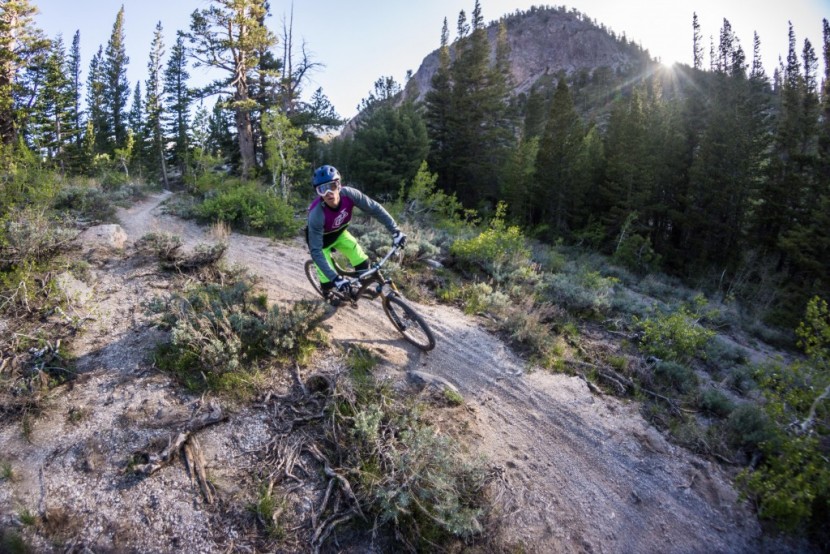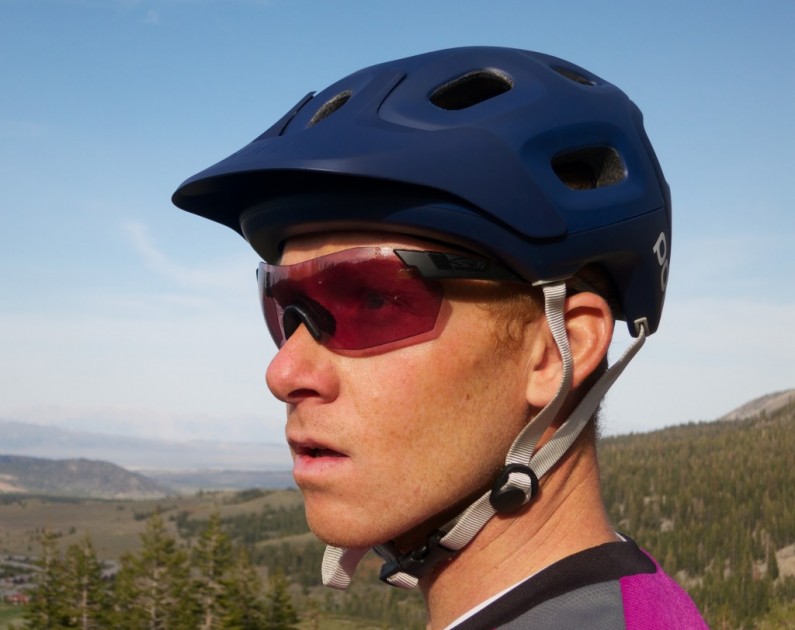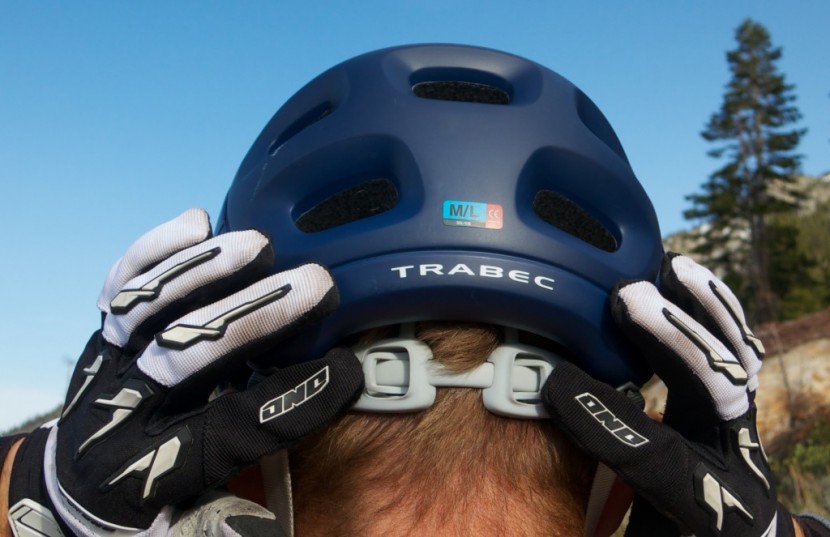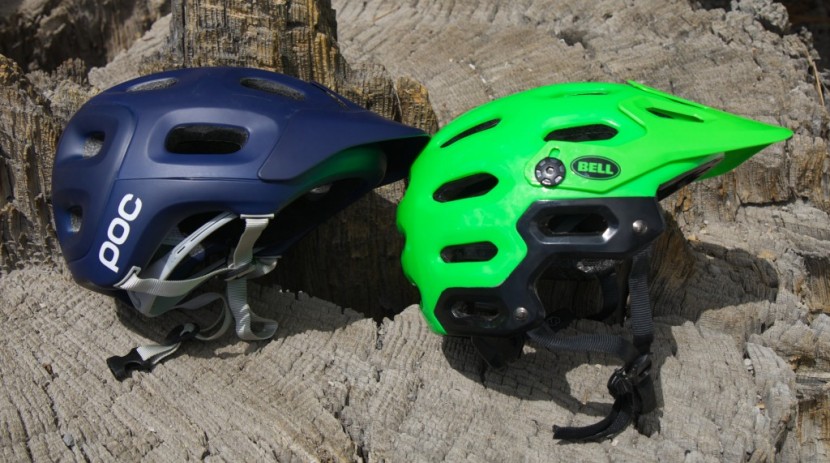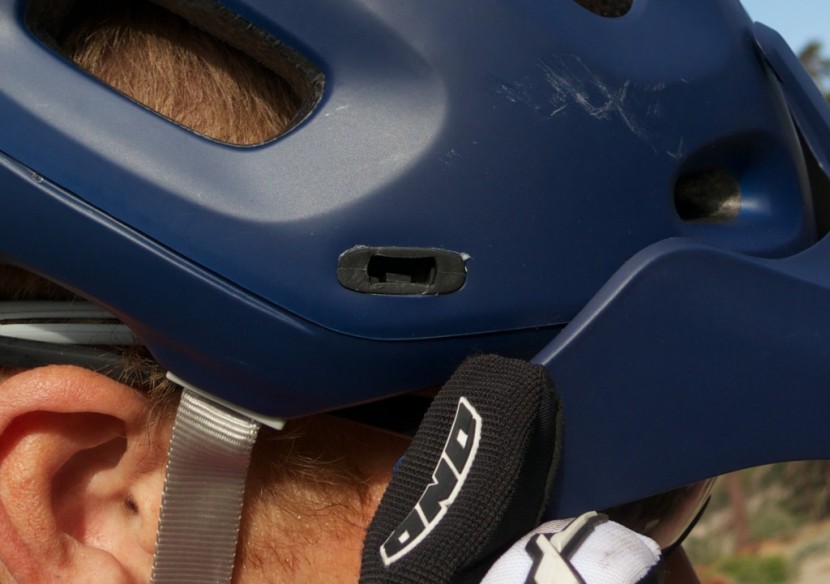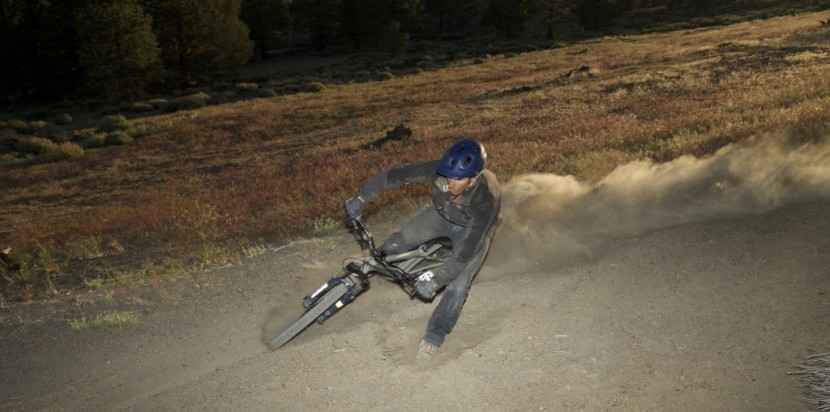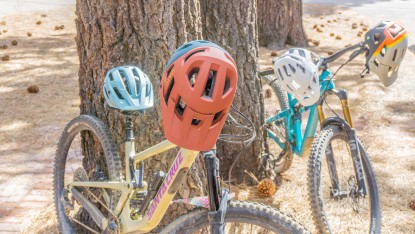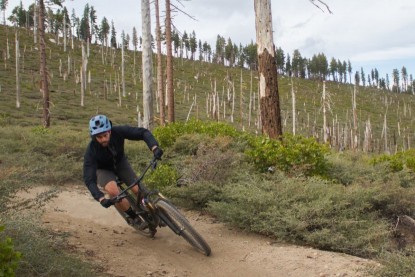Due to its popularity, the POC Trabec was the most anticipated helmet by our testers. Unfortunately it proved to be the most disappointing helmet in our test. Its biggest disappointment is the rear adjustment band, which uses buttons rather than a wheel to tighten the band. It results in a loose fit that does not stay locked on when the helmet is pushed upwards. Our testers felt more confident in helmets which felt locked on, and the Trabec is one of the least secure feeling helmets in our test. Like all of the mountain bike helmets in our test, the Trabec has a visor to shield the riders' eyes from sun, mud, or rain. However, this visor is one of the smallest and lacks any useable adjustments.
The Trabec is a well-made helmet, but it lacks the adjustability and special features we found on other standout helmets. Simply put, there is nothing special about the Trabec except for its recognizable look. The Trabec is also one of the most expensive helmets in our test. If you are looking to spend around $150 on a helmet, we recommend you spend an extra $15 and get our Editors' Choice Award winning Troy Lee A1 for $165 or spend $25 less and get a Bell Super for $125. We feel that both are considerably better helmets for the money.POC Trabec Review
Our Verdict
Our Analysis and Test Results
The POC Trabec is a half-shell mountain bike helmet with more rear and side coverage than traditional mountain bike helmet designs. The Trabec has a snap on visor which is minimally adjustable and does not securely stay put. The rear adjustment band requires two hands to operate, making it hard to tighten while riding single track. Even when the band is cranked tight, the helmet felt loose on our heads and shifted around more than any other helmet we tested.
Comfort
The inside of the Trabec is one of the sparsest padded helmets we found. What padding there is, is very thin. The hard plastic rear adjustment band has no padding at all. These things combine to give the Trabec a low comfort score by our testers. In fact, the Trabec tied the Bell Super with the lowest comfort score in our test. The Super has a lot of other redeeming qualities, which might make it worth a couple of pressure points. We can't say the same for the Trabec, which did not stand out in any of our tests.
For the king of comfort, we highly recommend the Troy Lee A1, which took the top comfort score and feels more like a well-worn fitted cap than a bike helmet.
Adjustments
The Trabec also took the bottom score in the adjustment category, which is a measure of how well a helmet can be adjusted to an individual rider's head. In this test, we closely take into consideration the design of the rear adjustment band, how that band is tightened, and how the chin strap and yoke can be positioned.
The Trabec's rear retention band adjusts with two small buttons which require two hands to operate. This system is similar to many lightweight rock climbing helmets. Our testers who also climb find two handed adjustment adequate for climbing, but miss the click wheel for bike riding. Of the helmets we tested, only the Trabec and the Fox Flux lack click wheels. Click wheels not only make initially tightening the helmet easier, but also allow for quick one-handed adjustment in the saddle. We think one-handed adjustment is especially important on a mountain bike where you are unlikely to be riding with both hands off the bars for very long.
The position of the Trabec's chin strap can be adjusted front to back using the simple plastic hardware which connects the chin strap to the yoke. This hardware gets the job done, but our testers prefer helmets which use locking hardware to firmly fix the chin strap in the ideal position. All of the other helmets we tested use locking hardware except for the Giro Feature, which, in order to remain lightweight, skips the hardware and the chin strap is permanently sewn to the yoke.
Weight
At 12 ounces, even in size medium/large, the Trabec is one of the lighter helmets we tested. It weighs less than an ounce more than the lightest helmet in our test, the Giro Xar, while having slightly more rear and side coverage than the Xar. The Trabec also weighs just slightly more than both the Giro Feature and Bell Stoker, which we consider to be the closest competitors. All three of these other helmets weigh less than the Trabec, yet have much more user-friendly rear retention systems.
For comparison, the heaviest helmet in our test is the Bell Super, which weighs in at 14.6 ounces in medium. While the Super is nearly 22 percent heavier than the Trabec, the Super does a much better job of staying put on the head, which makes it a lot less distracting, even with the added weight. This goes for a lot of the helmets we tested, in fact. Our testers found that secure fitting helmets feel lighter, are less noticeable, and boost confidence while riding regardless of their weight. Weight is certainly a factor in how well mountain biking gear performs, but function is also important.
Ventilation
The Trabec falls in the middle of the pack in terms of ventilation. Sixteen vents may not seem like a huge number compared to a helmet like the Bell Super, which has 25, but the vents on the Trabec are quite large and make up a large percentage of the total shell of the helmet. The top vents of this helmet are connected with front to back channels inside the helmet to promote airflow when riding. We found the Trabec to be very similar to the Bell Stoker, Troy Lee A1, and Giro Feature when it came to moving air in and out of the helmet and keeping things cool.
The sparse inner padding of the Trabec lacks a continuous band of padding across the brow area. Instead, it has strips of padding which run front to back in this area and do nothing to prevent sweat from running unimpeded down your forehead and onto the inside of your sunglasses. We prefer a continuous sweatband like the one found on the Bell Stoker, which does a better job of redirecting brow sweat away from our optics.
If ventilation is your top priority in a helmet, then we suggest the Giro Xar, which took the top score in our ventilation test with its huge vents and airy design.
Features
The Trabec's visor is connected with two horizontal snaps, which allow for a small amount of up and down adjustment. In order to stay in place, the visor relies on friction between the center of the visor and the front of the helmet. We found that this system is greatly inferior to helmets like the Giro Feature or Troy Lee A1 which use two screws to attach and pivot the visor and another thumb screw to change the amount of friction needed to adjust the visor. These thumb screws can also be used the firmly lock the visor at a certain angle. Our absolute favorite and the most adjustable visor was found on the Bell Super, which uses a slightly different system to attach and secure its massive shield.
The Trabec tied the Fox Flux with the lowest score in the features category, which examines the visor and any other extras a helmet may have. Besides the visor, the Trabec has no other notable features like camera mounts or alternative goggle attachments, and like we said above, there are much more impressive visors out there.
Durability
We did find the Trabec to be very durable over the course of our test. We like that the polycarbonate outer shell wraps well around the bottom of the edge of the helmet to protect the underlying polystyrene foam. We found that helmets which fully wrap the bottom edge in shell material are much less likely to get dents in this area, which is vulnerable when the helmet is off your head. Though it isn't the most secure, the rear adjustment band has sections of a rubbery material which allows it to flex a little more than most and may prevent it from breaking when the helmet is rolling around in your trunk.
Remember that all the lightweight half shell helmets we tested are designed to be replaced after a significant impact.
Best Application
This helmet is designed for any trail riding that falls between cross-country racing and full-face territory. Some call this enduro, we just call it mountain biking.
Value
At $150, the Trabec is the second most expensive helmet we tested. Only our Editors' Choice, the Troy Lee A1 (in the fancier color schemes), retails for more than the Trabec. We think the A1 is well worth the money while the Trabec is not. Our testers preferred both the Giro Feature and Bell Stoker over the Trabec. The Feature retails for just $75 while the Stoker is $5 less at $70 and both of these helmets are lighter than the Trabec and have awesome click wheels to make easy adjustments while riding.
Conclusion
The Trabec is decently durable but lacks the convenience of a click wheel on the rear band. The visor does not stay put due to its simplistic attachment. Besides its recognizable look, the Trabec has little else that sets it apart from other helmets, and since it is one of the most expensive helmets we tested, we suggest you check out other models.



